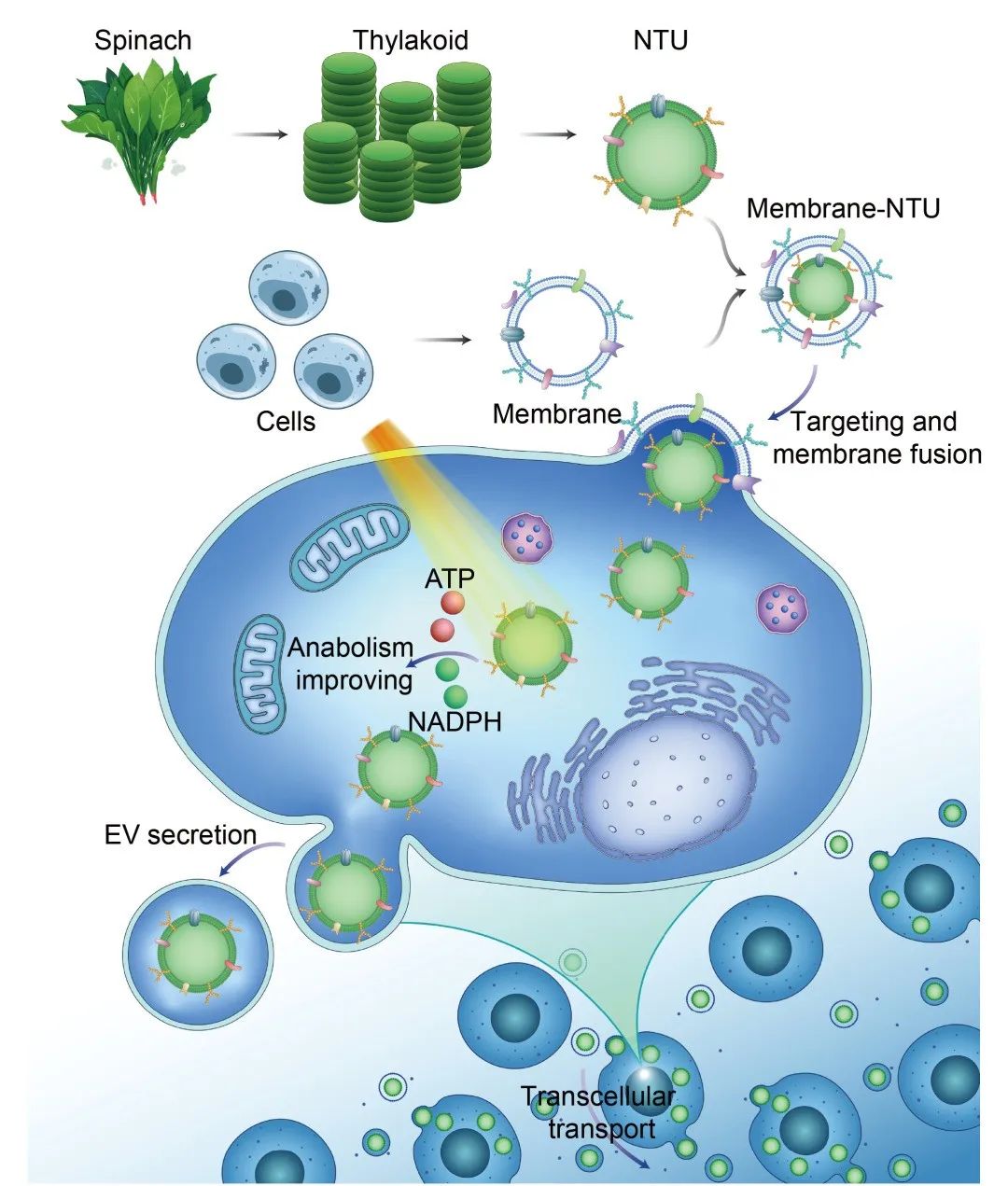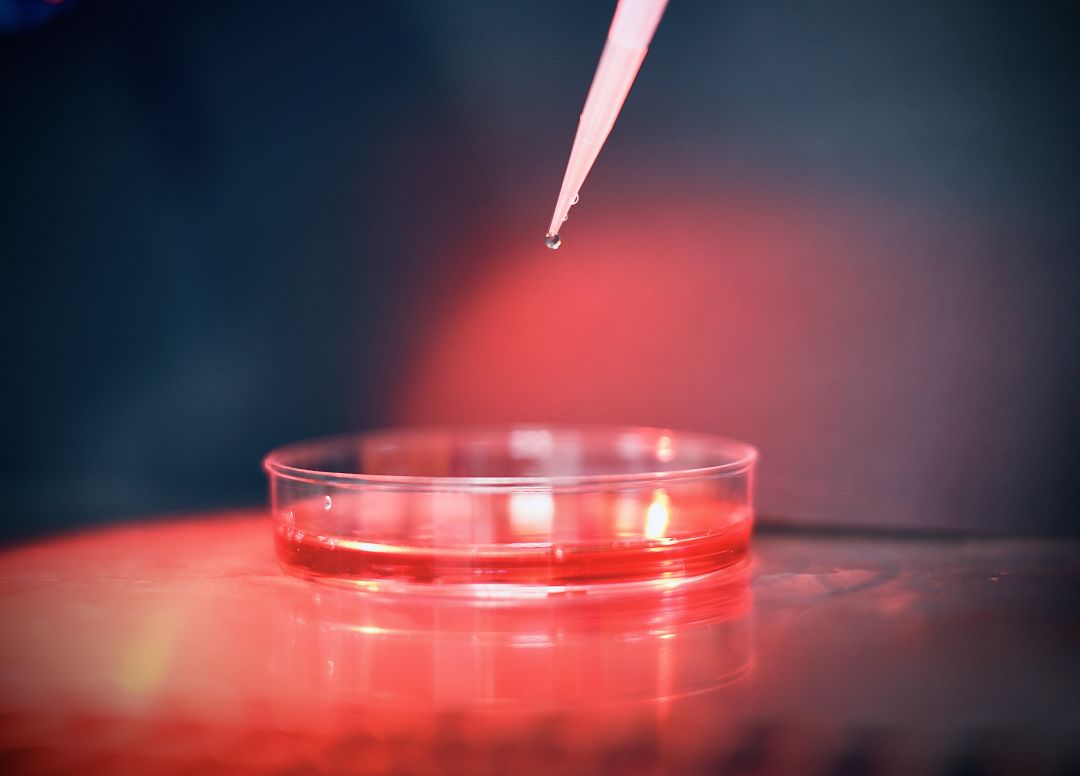SRRSH scientists unlock the "code" of energy transmission across species
2022/12/20Editor: LIN Xianfeng
Reviewer: SI Xiaocai (Shelia)
Spinach has left deep childhood memories for many post-70s and post-80s generations because of the cartoon image of "Popeye". Apart from appearing on our table as usual, it is truly endowed with the expectation of "great power" by scientists. The team of Dr. LIN Xianfeng and Prof. FAN Shunwu, from the orthopedics of Sir Run Run Shaw Hospital (SRRSH), Zhejiang University School of Medicine, and the team of Prof. TANG Ruikang from the Zhejiang University Department of Chemistry, successfully extracted the "biological battery" with photosynthesis - thylakoid from spinach, and through sophisticated preparation technology, delivered the thylakoid across species to the animal’s aging cells with lesions for the first time in the world, allowing animal cells to have the energy of photosynthesis like plants, so as to open the "Time Gate" of reversing cell degeneration and aging.
This original research result was published in journal Nature On December 8.
"Follow the laws of nature, make innovative breakthroughs in the world problem of delivering energy to cells, and open up the possibility of metabolic engineering." The senior editor and reviewer of Nature highly praised these latest research results of the team from Zhejiang University. It was reported that the most exciting part of this research was that the team developed the cell membrane nanocoating technology, which covered the mammalian cell membrane in the outer layer of the nanothylakoid, and skillfully transplanted the plant thylakoid into mammalian cells through the way of camouflage and encapsulation of the cell membrane, successfully unlocked the "code" of energy transmission across species and achieved energy supply specifically, which was verified in the treatment of degenerative osteoarthritis.
With the progress of disease research, more and more studies had found that the lack of energy in animal cells was the key reason for the occurrence of tissue aging and the development of degenerative diseases. Just as human beings need nutrition three times a day, cell renewal and metabolism also need energy and supplies. Exactly, ATP and NADPH are indispensable energy currency and material currency for cell regeneration and repair. However, it was a huge scientific problem to provide direct energy and materials to degenerative cells.

Prof. LIN Xianfeng (left) and Dr. CHEN Pengfei in the lab
An idea burst into LIN Xianfeng’s mind, "Can we design a 'charging' device to controllably generate ATP and NADPH in cells?" The brainstorming triggered by the cross discussion between the two groups of medicine and chemistry opened up a new world of research. However, scientists had made great efforts to use biological materials to synthesize ATP and NADPH, but how to make cells "accept" such a foreign device and precisely regulate the concentration of ATP and NADPH had always been a world-class problem in this field.
Based on the long-term exploration in the field of biomaterials from the orthopedic research team of SRRSH, the chemical biology research idea of "materials regulate biology" provided by the TANG Ruikang's team and the concept of "artificial organelle", the whole team keenly turned their eyes to the magical nature. In the natural world, plants and animals form a perfect complementary relationship. As you can see, plants produce oxygen and sugar by absorbing carbon dioxide, while animals do the opposite. Can we realize this complementary relationship at cellular level and make the plant energy supply system become the "biological battery" for animal cells to supply energy by implanting "photosynthetic organelles"?
For billions of years, plants have evolved an almost perfect organelle used for energy supply — thylakoid, which is exactly an energy factory that can generate ATP and NADPH in a controllable and stable way. The researchers selected spinach as the raw material, which is the greenest in the vegetable market and widely used in the field of plant metabolism, and through great efforts, successfully extracted and purified thylakoid from spinach green leaves.
The "battery" for energy supply was prepared and next problem was the "interface". How to deliver thylakoids safely and accurately to the aging and degenerative cells of animals has become a huge problem that limited their medical application. For a long time, the research on cross species delivery of bioactive components had progressed slowly. Especially the human body has a complex immune system. Various immune cells, mainly macrophages, will actively recognize and phagocytosis invaders, and then digest them through lysosome degradation.

Schematic diagram of membrane-coated nanothylakoid units
How can we overcome the barriers between species? Dr. CHEN Pengfei, one of the first authors of the paper, tried many delivery methods such as liposome encapsulation but never achieved the desired results. "How about using the membrane of the cell itself to encapsulate it? Let the cell think that the thylakoid we deliver was "their own" by using the principle of homologous targeting, so as to avoid immune rejection in the body and realize cross-species transplantation of nanothylakoids."
Inspired by LIN Xianfeng and encouraged by FAN Shunwu and TANG Ruikang, the team successfully "disguised" the nanothylakoids with the cell membrane and achieved the intracellular delivery of nanothylakoids with bold assumptions and careful verification.
"The escape of exogenous biomaterials from lysosomes is an important link to achieve successful delivery. We had repeatedly verified that animal cells no longer removed nanothylakoids as 'foreign bodies' through a variety of endocytosis inhibition tests, so that the thylakoid became a part of it." Dr. Liu Xin, another first author,added, which meant that the research team mastered the "futuristic tech" to delay the degeneration and aging of animal cells.
What key role did nanothylakoid play in cells? In the process of publishing this research achievement, four international top reviewers from biological materials, cell metabolism, clinical medicine and other fields put forward a series of suggestions and improvements to the team around this core issue.
After one year or even more of experiments and analyses, the team verified that the nanothylakoid can retain the protein and other functional monomers required for photosynthesis on the thylakoid, maintain sufficient action time and degradation stability, and ensure the sufficient production of ATP and NADPH, so as to systematically reverse the metabolic state of pathological cells through a variety of interdisciplinary technologies. "The validation involved fine modeling and calculation, especially for the analysis of the output of ATP and NADPH and their exact concentration levels, which gave us a new understanding of the research results," doctoral student GU Chenhui, one of the first authors, said.
During the review process, the most concerned problem of the international top reviewers in different fields was the role this exciting "futuristic tech" – nanothylakoid can play in vivo.
In order to test whether this kind of "biological battery" can reverse the metabolic state of diseased cells, the team first selected the disease model of osteoarthritis to carry out "conceptual verification". Osteoarthritis is one of the most important causes of deformity and disability in clinical practice. It is precisely because of the imbalance of energy metabolism of chondrocytes and the depletion of ATP and NADPH that destroys the articular cartilage. At present, the clinical prognosis of osteoarthritis is still poor since the biological treatment can’t systematically correct the metabolic imbalance of injured and degenerated chondrocytes.
Led by FAN Shunwu, the team continuously sought various interdisciplinary technologies for more than one year and systematically verified that the nanothylakoid encapsulated by the membrane of cartilage cells can not only effectively escape the elimination of the immune system, but also be selectively taken by degenerated cartilage cells. Through non-invasive light therapy in vitro, the level of ATP and NADPH in degenerated chondrocytes can be precisely enhanced and sufficient "endurance" can be maintained, which reshaped the anabolism of chondrocytes and achieve the treatment of degenerative osteoarthritis.

Schematic diagram of light stimulated chondrocytes
"How to deliver energy to cells has always been a huge problem in cell biology and clinical medicine, and the correct supply of specific metabolite is a lasting challenge in clinical treatment. There is no better way to solve the above problems than to deliver thylakoids, a factory that has evolved over billions of years of life." George Caputa commented, who is a senior editor of Nature.
The paper reviewer, Prof. Francisco Cejudo said, "The outstanding point of this work is that the research team has successfully transplanted plant 'micro organelles' into mammalian cells. The technology of using plant photosynthesis system to specifically supply ATP and NADPH in mammalian cells under light is an exciting achievement, which opens up the possibility of metabolic engineering."
Meanwhile, the column "Research briefing" of Nature published Plant-Cell Machinery for Making Metabolites Transferred to Mammalian Cells, which vigorously publicized and positively evaluated the research results.
"This research shows a biomedical application, namely, a cross-species transplantation of thylakoids from natural plants to mammalian cells. The key raw materials of this research are from natural plants with high biosafety. At the same time, the cell membrane nanocoating technology has the potential for large-scale production, which is expected to be applied in medicine, energy, materials and other fields in the future," TANG Ruikang said.
"The success of this research is attributed to the atmosphere of free exploration in the Sir Run Run Shaw Hospital, the unanimous support of the school, college, hospital and department, and also the support of the National Natural Science Foundation of China and the National Key R&D Program of the Ministry of Science and Technology," FAN Shunwu added. It was reported that the team had been deeply engaged in the research on the mechanism of the skeletal muscle system degenerative diseases and the development of biological materials from nature. Constantly making bold attempts to cross disciplines, team had successively published a series of highly influential research results in Nature, Matter, Developmental Cell, Nature Communications, Science Advances, JACS and other authoritative journals, meanwhile, achieved the application of new clinical technologies for various common and difficult diseases, including spine, joint, bone injury, wound repair and so on.
Nowadays the research team has simultaneously submitted patents for invention and started product transformation.
Nature Link: https://www.nature.com/articles/s41586-022-05499-y







